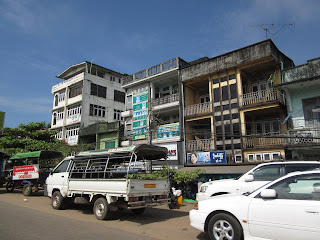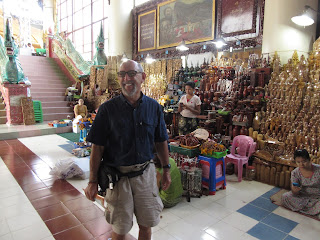The same driver we had had yesterday picked us up again at 8 from our hotel in Kingpun, located in Myanmar's Mon province and drove us toward Bago, located in the province of the same name. In case you didn't read the previous post, I had made arrangements months ago for us to spend a few hours discovering the major temples in Bago today before the driver would take us to Yangon's airport so we could catch a flight to our next destination.
Photos en route to Bago:
Female novice monks.
Rubber trees in the background.
Another procession but no elephants or horses this time
Young children waving Buddhist prayer flags.
Photos of rural Myanmar:
We must have seen a thousand of those Myanmar
beer signs while in Myanmar - they were everywhere even on people's houses.
Wooden footbridges were a common sight in rural Myanmar.
The trishaw, above, was a very common form of conveyance in rural Myanmar ,
we discovered.
We saw this "Welcome to Bago' sign about 20 minutes before entering the city or at least it felt like it! We arrived in Bago, a former capital with about
200,000 people, about 10 so we had a couple of hours to see some of the city’s
more famous pagodas before our driver had to drop us off at the airport in
Yangon for our mid afternoon flight to Bagan.
Our first stop in Bago was at Shwemawdaw Pagoda, photos of which are below.
According to murky legend, the
original stupa was a small, ramshackle object built by 2 brothers to enshrine 2
hairs given to them by Gautama
Buddha (the original Buddha).
In 982, a sacred tooth was added to the collection. In 1385 another tooth was
added and the stupa was rebuilt to a towering 277 feet. In 1492 strong
winds blew over the hti or finial ornament that tops
pagodas in Myanmar and a new one was raised.
The main part of the pagoda was undergoing renovation, thus the beehive look, i.e. the scaffolding.
At the northeastern corner of the stupa, we saw a huge
section of the hti that was toppled by the 1917 earthquake and
then mounted into the structure of the stupa.
After traveling through Myanmar for the last 2 weeks, this was the first and only sign I noticed concerning assistance available for the handicapped.
Our driver took us to Snake Monastery next.
It was called that because the former head of a monastery up
north was reincarnated in the form of an enormous 118 year old Burmese python.
Apparently the snake told its owner the exact address he needed to go to in
Bago in order to complete the construction of a stupa begun in a previous life.
Photos of Bago en route to Shwethalyaung Buddha:
We also passed both a Catholic church and a Hindu temple as
well as lots of Buddhist monasteries on the way.
The driver stopped in front of us this pagoda long enough for me to take a picture of its entrance and its reclining buddha before driving onto the nearby Shwethalyaung Buddha, our next stop.
Photos of Shwethalyaung Buddha:
The story of Shwethalyaung Buddha:
Once upon a time, a nasty king ruled the lands around what is today Bago. His reign was marked by corruption and violence but one day his son was out hunting in the forest where he fell in love with a Buddhist girl from Mon. Even though he and everyone else in his father’s kingdom worshipped pagan idols, the two became lovers and married after he promised he that she could continue to practice Buddhism. The king was furious when he found out and ordered the execution of both his son and wife. But, when the new bride prayed in front of the pagan idol, it cracked and broke. The king was scared and ordered the building of a Buddha statue and the conversion of the population to Buddhism.
We had to pass by a long of stalls all of whose vendors exhorted us to buy souvenirs before reaching the pagoda itself.
Bago was completely ravaged in 1757 and the huge Buddha was totally lost
and overgrown by jungle. It was not rediscovered til 1880 and restoration began
a year later.
The Buddha measures 180' long and 53' high.
In the 1930s a mosaic was added to the great pillow under
the Buddha’s head.
More souvenir stalls!
Our last stop in Bago was the
Built in 1476, the Kyaik Pun Pyo consists of four 100 foot
high sitting buddhas placed back to back around a huge square pillar. According
to legend, 4 Mon sisters were connected with the construction of the buddhas;
it was said that if any of them should marry, one of the buddhas would
collapse. One of the buddhas did collapse in the 1930 earthquake, leaving only
a brick outline and a very old bride!
Pretty fancy nails, huh!
We were really glad to have been able to see the pagodas and buddhas at Bago but were also looking forward to our next stop in Myanmar, Bagan, which we flew to that afternoon.
Posted on 11/30 from Kuala Lumpur, Malaysia.








































































